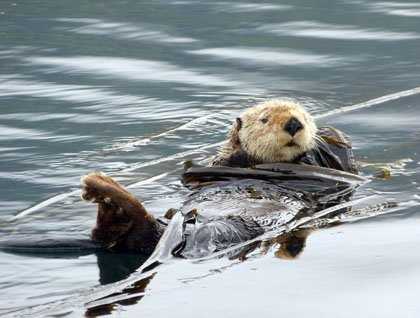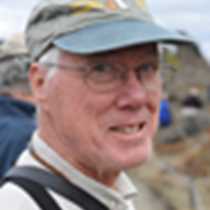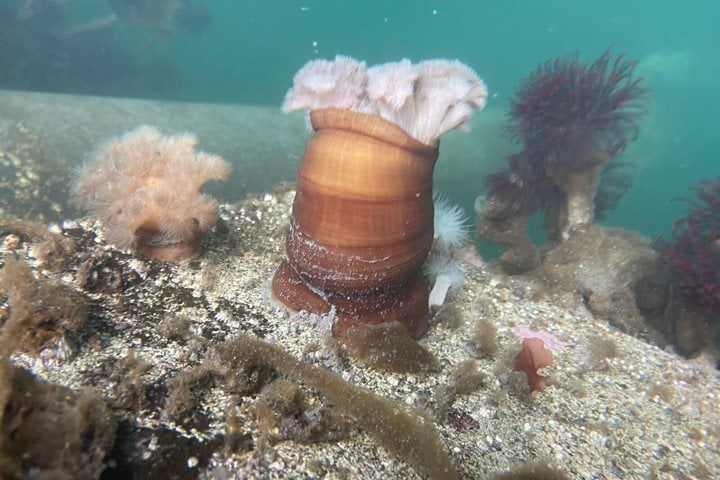It takes an enormous volume of water to raise the water level of Alaska's inland waterways by fifteen feet. On each rising tide that water must rush in from the Pacific Ocean, only to rush out again on the falling tide. Twice a day, up and down; the water comes, the water goes. We have watched the large changes in the tide during our trips ashore. All of this water flow must occur south of Baranof Island and north of Chichagof Island, where we are today. Icy Strait enters into Cross Sound with mighty tidal currents that squeeze around and between the Inian Islands, changing directions with the tides. The currents bring nutrient-rich water up from the depths, fueling marine productivity. Each rising tide also brings fish returning from the ocean to spawn in the streams and lakes of the Inside Passage. These two factors make these waters prime feeding sites for marine wildlife.
In the early morning, we were in Idaho Inlet, a narrow arm of the sea reaching into Chichagof Island. We were looking for (and finding) sea otters. Are they consummately cute fur balls, or are they aquatic weasels with a nasty disposition? The debate raged. It was hard to deny the former. The trade in valuable sea otter pelts brought Russians to Alaska beginning in the mid-1700s, and the exhaustion of the sea otters led Czarist Russia to sell the land to America in 1867 (as a way to keep their adversary, Britain, away from their border.)
We boarded our landing craft to cruise for closer views of the wildlife. Most of the sea otters were wary of our approach (perhaps a carryover from the era of exploitation), but the otter seen above wrapped itself in kelp and showed no concern. (Okay—cute wins.) We began to see Steller's or Northern sea lions. Some of our cruising guests wondered why we did not linger for photos, but our drivers knew that more awaited us. On a rock right at the entrance where tidal water streams by, there is a haul-out of these massive pinnipeds. They are much larger and lighter in color than the more familiar California or Galápagos sea lions that many have experienced on earlier Lindblad-National Geographic expeditions. On land, they roar (or some would say belch) rather than bark. A haul-out is a place where non-breeding animals assemble, mostly young males waiting to grow large and strong enough to compete for space on a breeding colony and the harem of females that comes with the territory. The way to grow large is to eat, and they alternate between feasting on fish brought by the incoming tide, and lounging on the rock when the tide is falling. We watched many a fish being ripped asunder in their feeding frenzy, the scraps quickly devoured by the attending escort of gulls.
George Island: kayaking, cruises around the island, a hike to a large gun left from the defense of Southeast Alaska in World War II. Sorry: running out of space, and I need to get to our evening in Icy Strait.
The ocean off of Point Adolphus is prime feeding habitat for humpback whales. During dinner, our bridge officers found them and they positioned the National Geographic Sea Bird perfectly for our viewing. All around us were whales only recently returned from their winter in tropical waters around Hawaii. There, females gave birth to their calves, and males competed to impregnate willing females. Now, breeding is over and it is time to feed and restore the layer of blubber that was exhausted during their winter of little or no feeding. One group of five, in particular, swam repeatedly around the ship. Each whale, with five or six massive exhalations, blew tall columns of mist high into the evening sky; then, one by one, they threw their flukes into the air and descended to seek out schools of herring to be consumed in massive gulps. Again and again, this was played out. We stood, transfixed, absorbing this ballet of 40-ton behemoths until the evening light faded (it was, after all, 10:00 p.m.) and we went to our beds, tired but contented.







